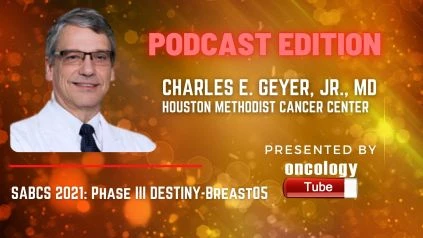Charles E. Geyer, Jr., MD, FACP, Deputy Director of the Houston Methodist Cancer Center, and Study Co-Chair speaks about SABCS Abstract – OT1-02-03 Trastuzumab deruxtecan (T-DXd; DS-8201) vs trastuzumab emtansine (T-DM1) in high-risk patients with HER2-positive, residual invasive early breast cancer after neoadjuvant therapy: A randomized, phase 3 trial (DESTINY-Breast05).
Background:
Preoperative chemotherapy with trastuzumab and pertuzumab is the primary treatment for HER2-positive, invasive, early breast cancer patients (pts) (BC). Patients who have undergone such treatment but still have invasive disease in the breast or lymph nodes at surgery are at a higher risk of disease recurrence or death than those who have received such treatment but have a histological full response. After appropriate neoadjuvant chemotherapy and trastuzumab, the antibody-drug conjugate (ADC) T-DM1 has been approved as a postneoadjuvant treatment for patients with persistent invasive disease (in the breast and/or axillary nodes) (or trastuzumab with pertuzumab). T-DXd is a powerful HER2-targeted ADC with an 8:1 drug-to-antibody ratio and a humanized HER2 antibody coupled to a membrane-permeable topoisomerase I inhibitor payload via a cleavable tetrapeptide-based linker. T-DXd is licensed worldwide for the treatment of adult patients with HER2-positive, unresectable, or metastatic breast cancer who have had at least two prior anti-HER2-based regimens in the metastatic setting or previous chemotherapy and are refractory to or intolerant of standard treatments. The results of DESTINY-Breast01, an open-label, multinational, multicenter, phase 2 study of T-DXd in patients with HER2-positive metastatic BC, backed up these approvals. In pts with HER2- positive (IHC 3+ or ISH+), unresectable or metastatic BC previously treated with T-DM1, T-DXd revealed an objective response rate (ORR) of 61.4 percent (113/184 pts) and a duration of response of 20.8 months in an updated data cutoff (June 8, 2020). (Modi et al. Cancer Res. 2021;81[4 suppl]:PD3-06). Patients who do not achieve a pathologic complete response to neoadjuvant treatment have a higher risk of recurrence, therefore there is still an unmet need. T-DXd vs T-DM1 as postneoadjuvant treatment for high-risk patients with HER2-positive primary BC who have residual invasive disease after neoadjuvant therapy is described in this paper.
Description of the research:
DESTINY-Breast05 is a multicenter, open label, randomized, phase 3 trial comparing the efficacy and safety of T-DXd and T-DM1 in patients with HER2-positive (IHC 3+ or ISH+, centrally confirmed on pretreatment biopsy), invasive breast cancer with pathologic evidence of residual invasive disease in the breast or axillary lymph nodes after neoadjuvant therapy. Pts must also have a higher residual risk of recurrence after standard T-DM1, which is defined as either inoperable disease (clinical stages T4, N0-3, M0 or T1-3, N2-3, M0) or operable BC at presentation (clinical stages T1-3, N0-1, M0) with axillary node-positive disease after neoadjuvant chemotherapy and anti-HER2 treatment. T-DXd or T-DM1 will be randomly assigned (1:1) to 1600 points from 400 sites throughout the world. Surgical status at presentation, hormone receptor status, pathologic nodal status following neoadjuvant therapy, and kind of HER2-targeted neoadjuvant therapy are all used to stratify the randomization (single vs dual). For 14 cycles, T-DXd 5.4 mg/kg or T-DM1 3.6 mg/kg will be given intravenously once every 3 weeks. The primary effectiveness outcome is invasive disease-free survival as determined by investigators. Overall survival, disease-free survival, distant recurrence-free interval, and brain metastasis-free interval are secondary goals. T-DXd pharmacokinetics, biomarkers, and health-related quality of life will be assessed as well (NCT04622319).

